University Course: Knowledge Management and Leadership Report
VerifiedAdded on 2023/03/30
|10
|1767
|422
Report
AI Summary
This report delves into knowledge management strategies, focusing on the four foundational elements established by the data shop: knowledge capture and creation, enrichment and sharing, information retrieval and storage, and dissemination. It emphasizes the importance of explicit and implicit knowledge, as well as the roles of people, processes, and technology in effective knowledge management. The report also identifies key indicators for evaluating an organization's progress toward becoming a learning organization, highlighting the shift from information retrieval to knowledge search. Furthermore, it explores the role of leadership in cultivating a learning environment, discussing the formalization of training plans, recognition of learning, and the development of knowledge-sharing processes. The case study of Centrelink is used to illustrate these concepts, providing real-world examples of how these strategies are implemented.

1
Name:
Course
Professor’s name
University name
City, State
Date of submission
Name:
Course
Professor’s name
University name
City, State
Date of submission
Paraphrase This Document
Need a fresh take? Get an instant paraphrase of this document with our AI Paraphraser
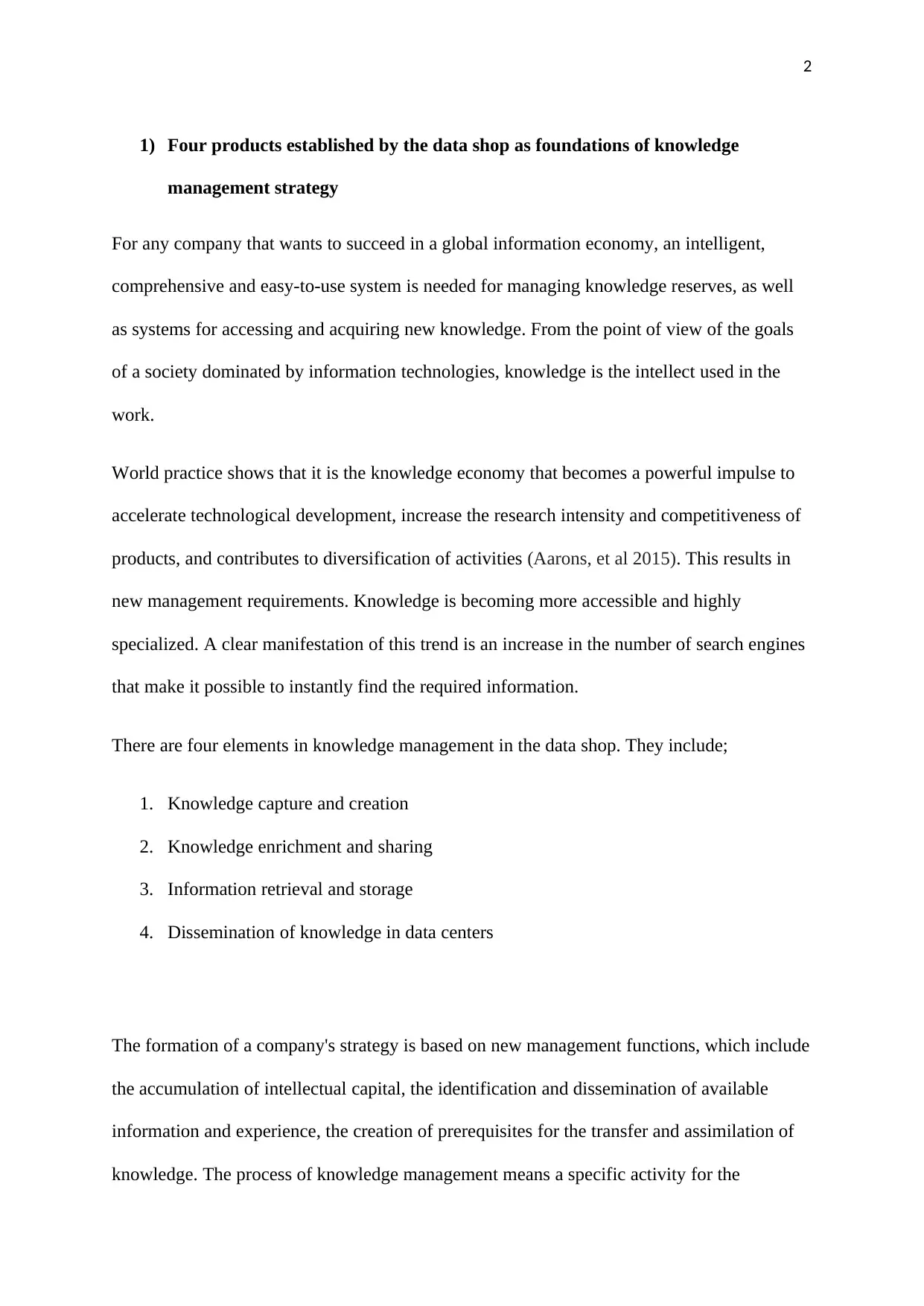
2
1) Four products established by the data shop as foundations of knowledge
management strategy
For any company that wants to succeed in a global information economy, an intelligent,
comprehensive and easy-to-use system is needed for managing knowledge reserves, as well
as systems for accessing and acquiring new knowledge. From the point of view of the goals
of a society dominated by information technologies, knowledge is the intellect used in the
work.
World practice shows that it is the knowledge economy that becomes a powerful impulse to
accelerate technological development, increase the research intensity and competitiveness of
products, and contributes to diversification of activities (Aarons, et al 2015). This results in
new management requirements. Knowledge is becoming more accessible and highly
specialized. A clear manifestation of this trend is an increase in the number of search engines
that make it possible to instantly find the required information.
There are four elements in knowledge management in the data shop. They include;
1. Knowledge capture and creation
2. Knowledge enrichment and sharing
3. Information retrieval and storage
4. Dissemination of knowledge in data centers
The formation of a company's strategy is based on new management functions, which include
the accumulation of intellectual capital, the identification and dissemination of available
information and experience, the creation of prerequisites for the transfer and assimilation of
knowledge. The process of knowledge management means a specific activity for the
1) Four products established by the data shop as foundations of knowledge
management strategy
For any company that wants to succeed in a global information economy, an intelligent,
comprehensive and easy-to-use system is needed for managing knowledge reserves, as well
as systems for accessing and acquiring new knowledge. From the point of view of the goals
of a society dominated by information technologies, knowledge is the intellect used in the
work.
World practice shows that it is the knowledge economy that becomes a powerful impulse to
accelerate technological development, increase the research intensity and competitiveness of
products, and contributes to diversification of activities (Aarons, et al 2015). This results in
new management requirements. Knowledge is becoming more accessible and highly
specialized. A clear manifestation of this trend is an increase in the number of search engines
that make it possible to instantly find the required information.
There are four elements in knowledge management in the data shop. They include;
1. Knowledge capture and creation
2. Knowledge enrichment and sharing
3. Information retrieval and storage
4. Dissemination of knowledge in data centers
The formation of a company's strategy is based on new management functions, which include
the accumulation of intellectual capital, the identification and dissemination of available
information and experience, the creation of prerequisites for the transfer and assimilation of
knowledge. The process of knowledge management means a specific activity for the
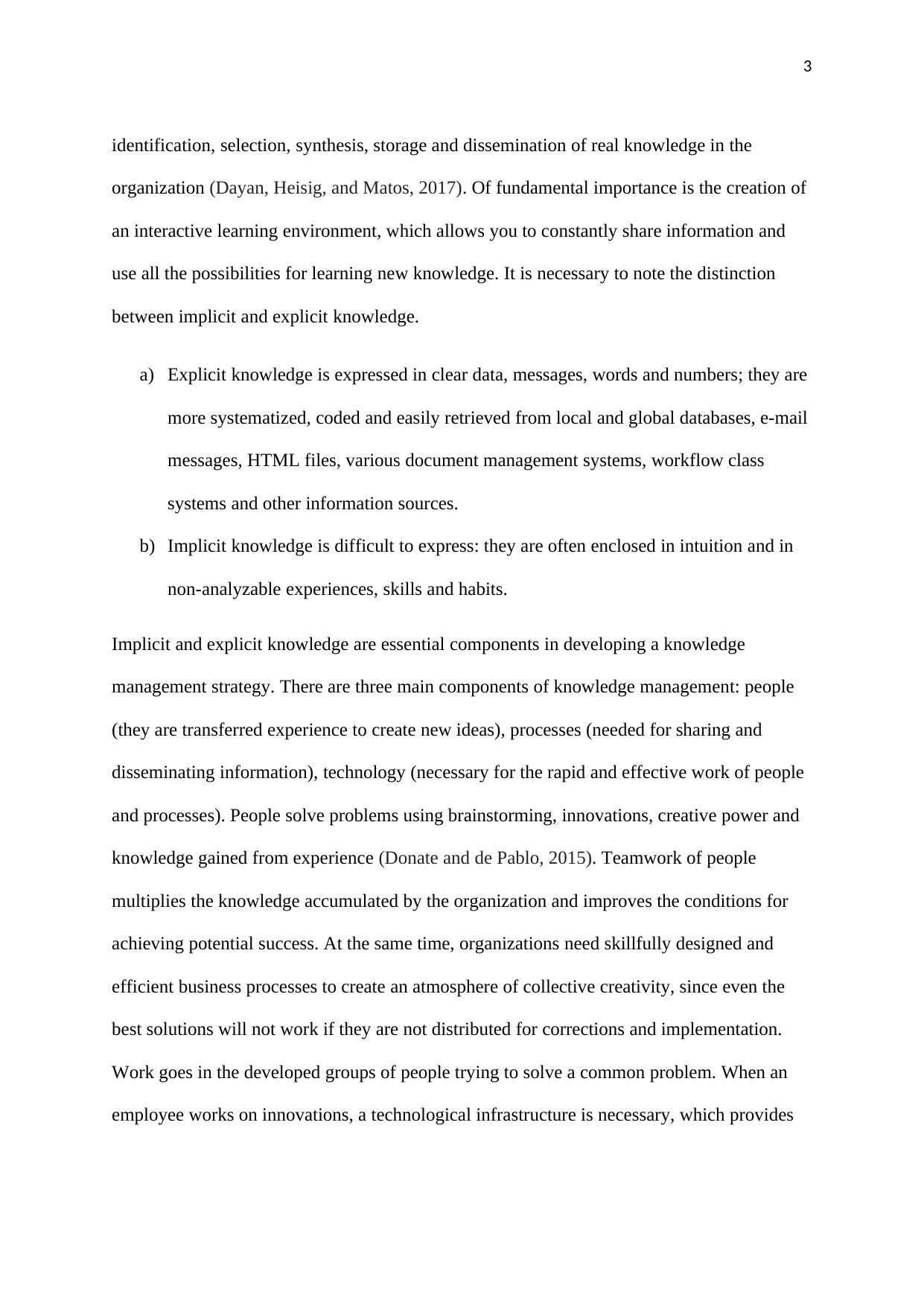
3
identification, selection, synthesis, storage and dissemination of real knowledge in the
organization (Dayan, Heisig, and Matos, 2017). Of fundamental importance is the creation of
an interactive learning environment, which allows you to constantly share information and
use all the possibilities for learning new knowledge. It is necessary to note the distinction
between implicit and explicit knowledge.
a) Explicit knowledge is expressed in clear data, messages, words and numbers; they are
more systematized, coded and easily retrieved from local and global databases, e-mail
messages, HTML files, various document management systems, workflow class
systems and other information sources.
b) Implicit knowledge is difficult to express: they are often enclosed in intuition and in
non-analyzable experiences, skills and habits.
Implicit and explicit knowledge are essential components in developing a knowledge
management strategy. There are three main components of knowledge management: people
(they are transferred experience to create new ideas), processes (needed for sharing and
disseminating information), technology (necessary for the rapid and effective work of people
and processes). People solve problems using brainstorming, innovations, creative power and
knowledge gained from experience (Donate and de Pablo, 2015). Teamwork of people
multiplies the knowledge accumulated by the organization and improves the conditions for
achieving potential success. At the same time, organizations need skillfully designed and
efficient business processes to create an atmosphere of collective creativity, since even the
best solutions will not work if they are not distributed for corrections and implementation.
Work goes in the developed groups of people trying to solve a common problem. When an
employee works on innovations, a technological infrastructure is necessary, which provides
identification, selection, synthesis, storage and dissemination of real knowledge in the
organization (Dayan, Heisig, and Matos, 2017). Of fundamental importance is the creation of
an interactive learning environment, which allows you to constantly share information and
use all the possibilities for learning new knowledge. It is necessary to note the distinction
between implicit and explicit knowledge.
a) Explicit knowledge is expressed in clear data, messages, words and numbers; they are
more systematized, coded and easily retrieved from local and global databases, e-mail
messages, HTML files, various document management systems, workflow class
systems and other information sources.
b) Implicit knowledge is difficult to express: they are often enclosed in intuition and in
non-analyzable experiences, skills and habits.
Implicit and explicit knowledge are essential components in developing a knowledge
management strategy. There are three main components of knowledge management: people
(they are transferred experience to create new ideas), processes (needed for sharing and
disseminating information), technology (necessary for the rapid and effective work of people
and processes). People solve problems using brainstorming, innovations, creative power and
knowledge gained from experience (Donate and de Pablo, 2015). Teamwork of people
multiplies the knowledge accumulated by the organization and improves the conditions for
achieving potential success. At the same time, organizations need skillfully designed and
efficient business processes to create an atmosphere of collective creativity, since even the
best solutions will not work if they are not distributed for corrections and implementation.
Work goes in the developed groups of people trying to solve a common problem. When an
employee works on innovations, a technological infrastructure is necessary, which provides
⊘ This is a preview!⊘
Do you want full access?
Subscribe today to unlock all pages.

Trusted by 1+ million students worldwide
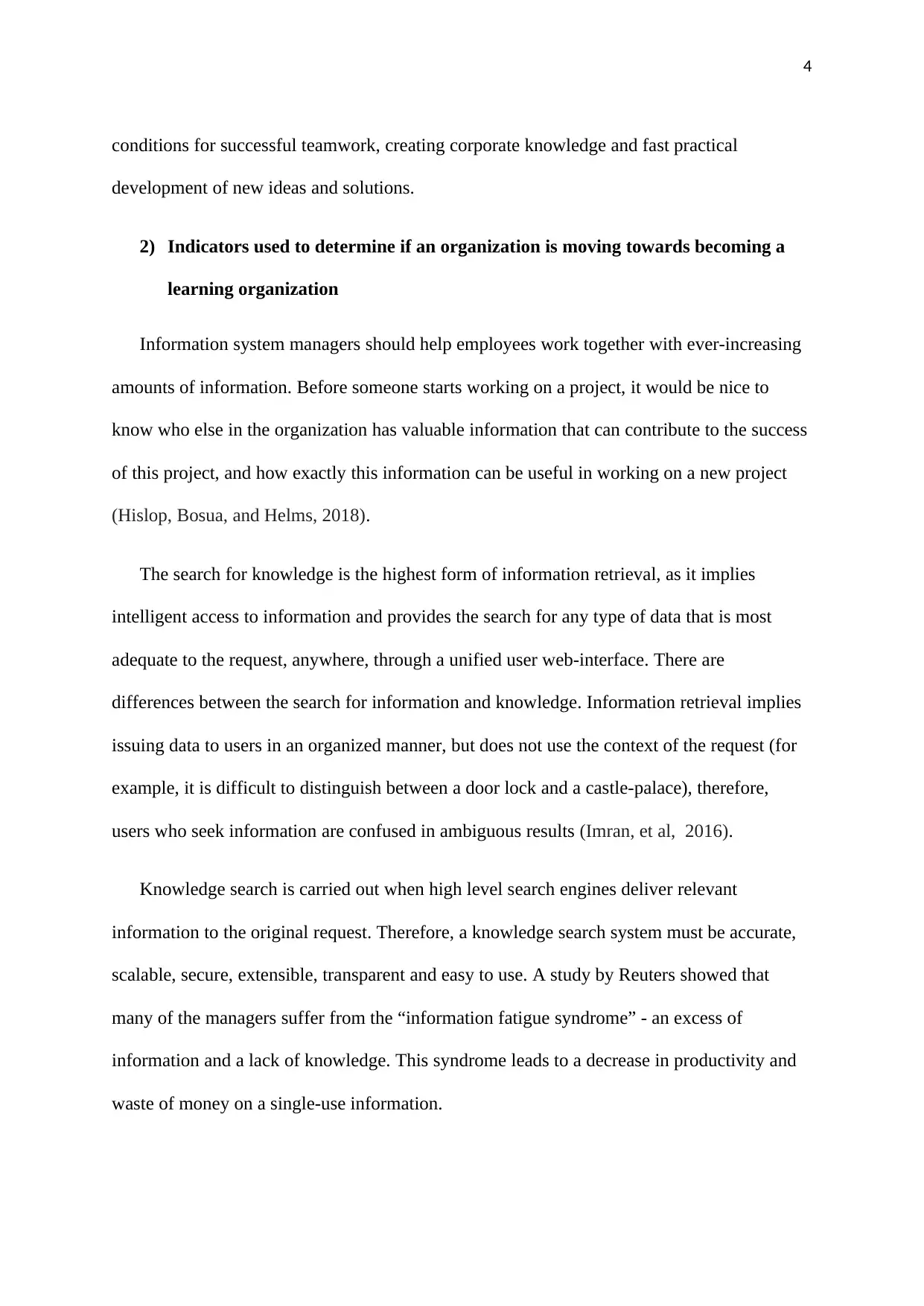
4
conditions for successful teamwork, creating corporate knowledge and fast practical
development of new ideas and solutions.
2) Indicators used to determine if an organization is moving towards becoming a
learning organization
Information system managers should help employees work together with ever-increasing
amounts of information. Before someone starts working on a project, it would be nice to
know who else in the organization has valuable information that can contribute to the success
of this project, and how exactly this information can be useful in working on a new project
(Hislop, Bosua, and Helms, 2018).
The search for knowledge is the highest form of information retrieval, as it implies
intelligent access to information and provides the search for any type of data that is most
adequate to the request, anywhere, through a unified user web-interface. There are
differences between the search for information and knowledge. Information retrieval implies
issuing data to users in an organized manner, but does not use the context of the request (for
example, it is difficult to distinguish between a door lock and a castle-palace), therefore,
users who seek information are confused in ambiguous results (Imran, et al, 2016).
Knowledge search is carried out when high level search engines deliver relevant
information to the original request. Therefore, a knowledge search system must be accurate,
scalable, secure, extensible, transparent and easy to use. A study by Reuters showed that
many of the managers suffer from the “information fatigue syndrome” - an excess of
information and a lack of knowledge. This syndrome leads to a decrease in productivity and
waste of money on a single-use information.
conditions for successful teamwork, creating corporate knowledge and fast practical
development of new ideas and solutions.
2) Indicators used to determine if an organization is moving towards becoming a
learning organization
Information system managers should help employees work together with ever-increasing
amounts of information. Before someone starts working on a project, it would be nice to
know who else in the organization has valuable information that can contribute to the success
of this project, and how exactly this information can be useful in working on a new project
(Hislop, Bosua, and Helms, 2018).
The search for knowledge is the highest form of information retrieval, as it implies
intelligent access to information and provides the search for any type of data that is most
adequate to the request, anywhere, through a unified user web-interface. There are
differences between the search for information and knowledge. Information retrieval implies
issuing data to users in an organized manner, but does not use the context of the request (for
example, it is difficult to distinguish between a door lock and a castle-palace), therefore,
users who seek information are confused in ambiguous results (Imran, et al, 2016).
Knowledge search is carried out when high level search engines deliver relevant
information to the original request. Therefore, a knowledge search system must be accurate,
scalable, secure, extensible, transparent and easy to use. A study by Reuters showed that
many of the managers suffer from the “information fatigue syndrome” - an excess of
information and a lack of knowledge. This syndrome leads to a decrease in productivity and
waste of money on a single-use information.
Paraphrase This Document
Need a fresh take? Get an instant paraphrase of this document with our AI Paraphraser
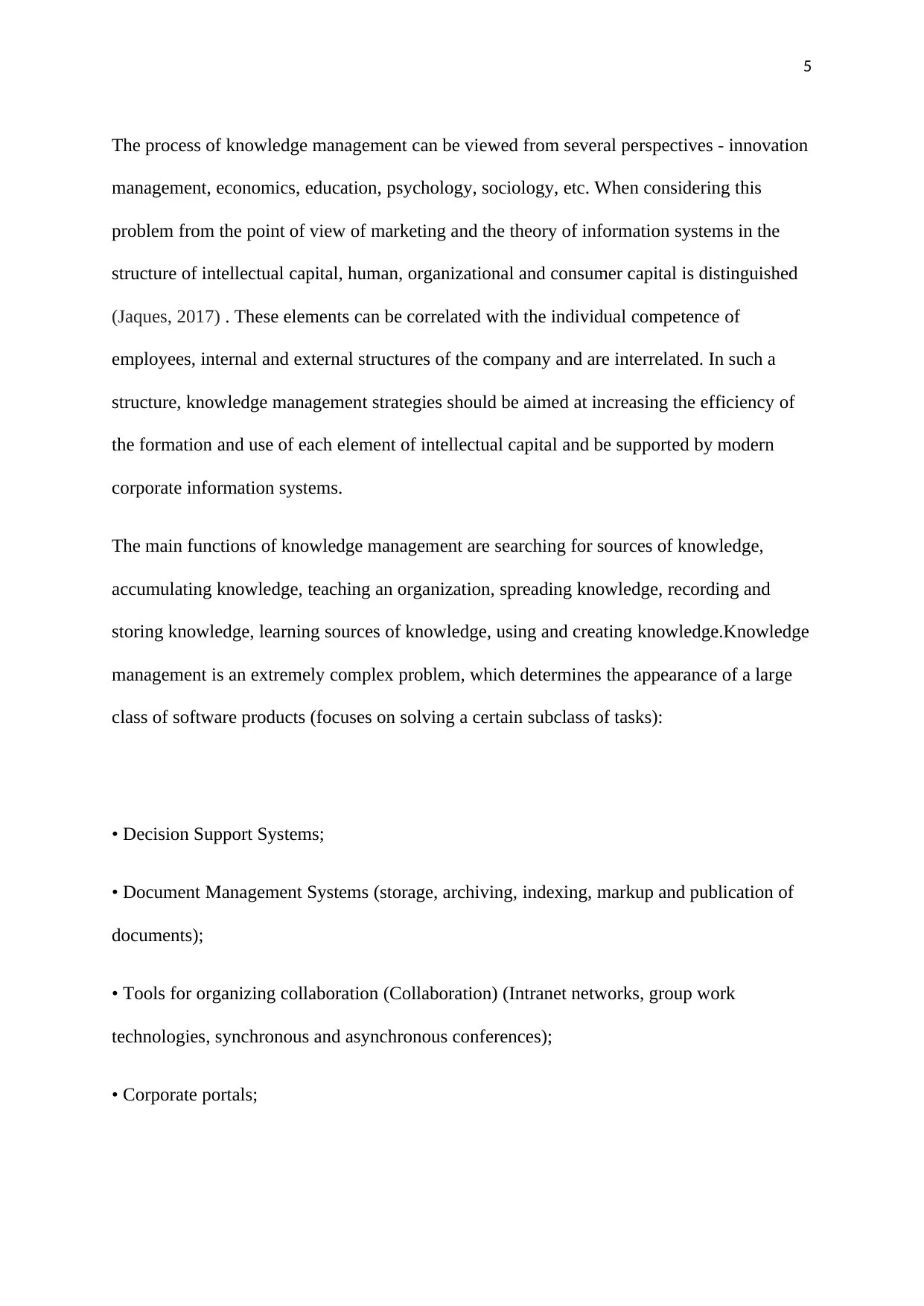
5
The process of knowledge management can be viewed from several perspectives - innovation
management, economics, education, psychology, sociology, etc. When considering this
problem from the point of view of marketing and the theory of information systems in the
structure of intellectual capital, human, organizational and consumer capital is distinguished
(Jaques, 2017) . These elements can be correlated with the individual competence of
employees, internal and external structures of the company and are interrelated. In such a
structure, knowledge management strategies should be aimed at increasing the efficiency of
the formation and use of each element of intellectual capital and be supported by modern
corporate information systems.
The main functions of knowledge management are searching for sources of knowledge,
accumulating knowledge, teaching an organization, spreading knowledge, recording and
storing knowledge, learning sources of knowledge, using and creating knowledge.Knowledge
management is an extremely complex problem, which determines the appearance of a large
class of software products (focuses on solving a certain subclass of tasks):
• Decision Support Systems;
• Document Management Systems (storage, archiving, indexing, markup and publication of
documents);
• Tools for organizing collaboration (Collaboration) (Intranet networks, group work
technologies, synchronous and asynchronous conferences);
• Corporate portals;
The process of knowledge management can be viewed from several perspectives - innovation
management, economics, education, psychology, sociology, etc. When considering this
problem from the point of view of marketing and the theory of information systems in the
structure of intellectual capital, human, organizational and consumer capital is distinguished
(Jaques, 2017) . These elements can be correlated with the individual competence of
employees, internal and external structures of the company and are interrelated. In such a
structure, knowledge management strategies should be aimed at increasing the efficiency of
the formation and use of each element of intellectual capital and be supported by modern
corporate information systems.
The main functions of knowledge management are searching for sources of knowledge,
accumulating knowledge, teaching an organization, spreading knowledge, recording and
storing knowledge, learning sources of knowledge, using and creating knowledge.Knowledge
management is an extremely complex problem, which determines the appearance of a large
class of software products (focuses on solving a certain subclass of tasks):
• Decision Support Systems;
• Document Management Systems (storage, archiving, indexing, markup and publication of
documents);
• Tools for organizing collaboration (Collaboration) (Intranet networks, group work
technologies, synchronous and asynchronous conferences);
• Corporate portals;
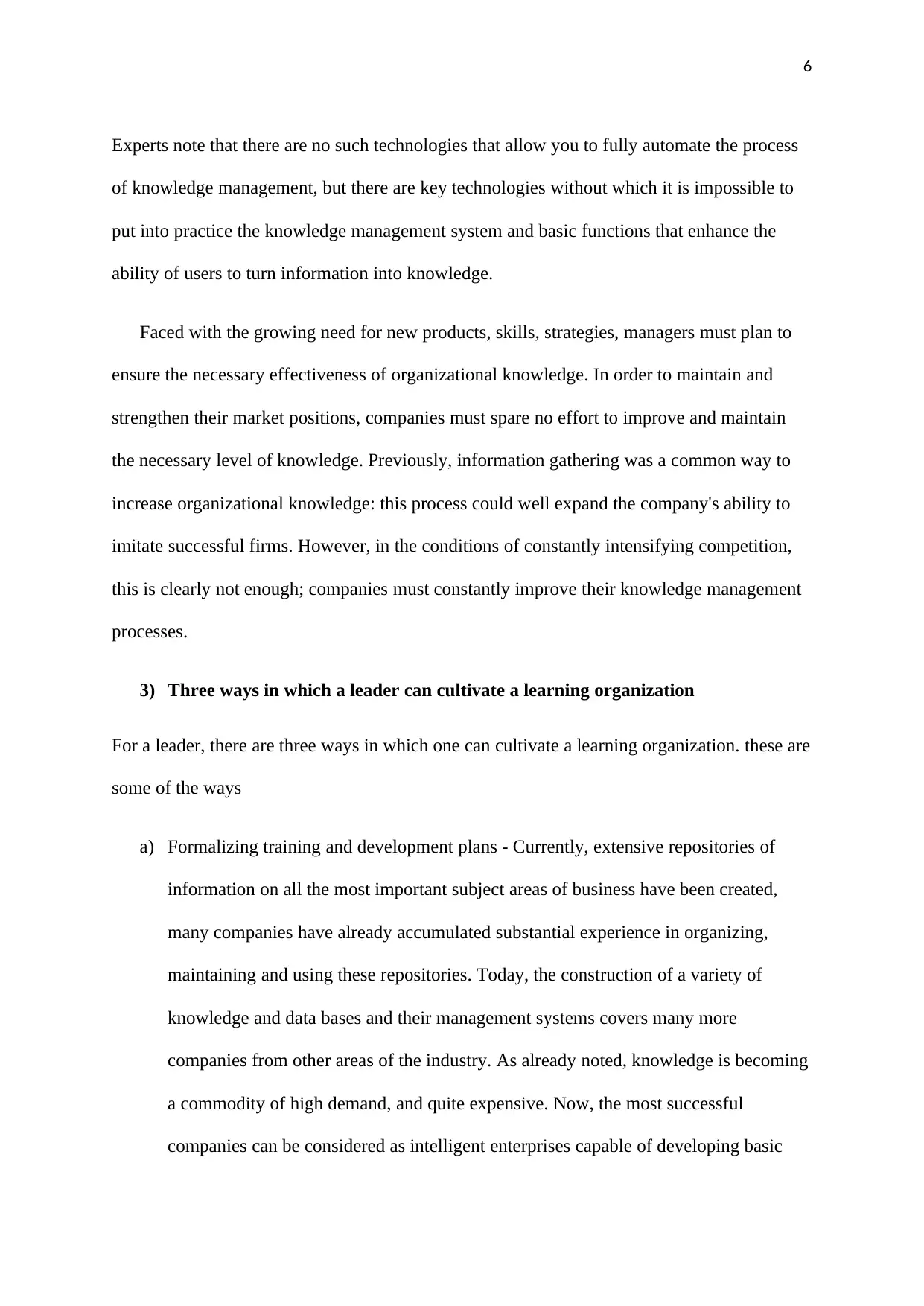
6
Experts note that there are no such technologies that allow you to fully automate the process
of knowledge management, but there are key technologies without which it is impossible to
put into practice the knowledge management system and basic functions that enhance the
ability of users to turn information into knowledge.
Faced with the growing need for new products, skills, strategies, managers must plan to
ensure the necessary effectiveness of organizational knowledge. In order to maintain and
strengthen their market positions, companies must spare no effort to improve and maintain
the necessary level of knowledge. Previously, information gathering was a common way to
increase organizational knowledge: this process could well expand the company's ability to
imitate successful firms. However, in the conditions of constantly intensifying competition,
this is clearly not enough; companies must constantly improve their knowledge management
processes.
3) Three ways in which a leader can cultivate a learning organization
For a leader, there are three ways in which one can cultivate a learning organization. these are
some of the ways
a) Formalizing training and development plans - Currently, extensive repositories of
information on all the most important subject areas of business have been created,
many companies have already accumulated substantial experience in organizing,
maintaining and using these repositories. Today, the construction of a variety of
knowledge and data bases and their management systems covers many more
companies from other areas of the industry. As already noted, knowledge is becoming
a commodity of high demand, and quite expensive. Now, the most successful
companies can be considered as intelligent enterprises capable of developing basic
Experts note that there are no such technologies that allow you to fully automate the process
of knowledge management, but there are key technologies without which it is impossible to
put into practice the knowledge management system and basic functions that enhance the
ability of users to turn information into knowledge.
Faced with the growing need for new products, skills, strategies, managers must plan to
ensure the necessary effectiveness of organizational knowledge. In order to maintain and
strengthen their market positions, companies must spare no effort to improve and maintain
the necessary level of knowledge. Previously, information gathering was a common way to
increase organizational knowledge: this process could well expand the company's ability to
imitate successful firms. However, in the conditions of constantly intensifying competition,
this is clearly not enough; companies must constantly improve their knowledge management
processes.
3) Three ways in which a leader can cultivate a learning organization
For a leader, there are three ways in which one can cultivate a learning organization. these are
some of the ways
a) Formalizing training and development plans - Currently, extensive repositories of
information on all the most important subject areas of business have been created,
many companies have already accumulated substantial experience in organizing,
maintaining and using these repositories. Today, the construction of a variety of
knowledge and data bases and their management systems covers many more
companies from other areas of the industry. As already noted, knowledge is becoming
a commodity of high demand, and quite expensive. Now, the most successful
companies can be considered as intelligent enterprises capable of developing basic
⊘ This is a preview!⊘
Do you want full access?
Subscribe today to unlock all pages.

Trusted by 1+ million students worldwide
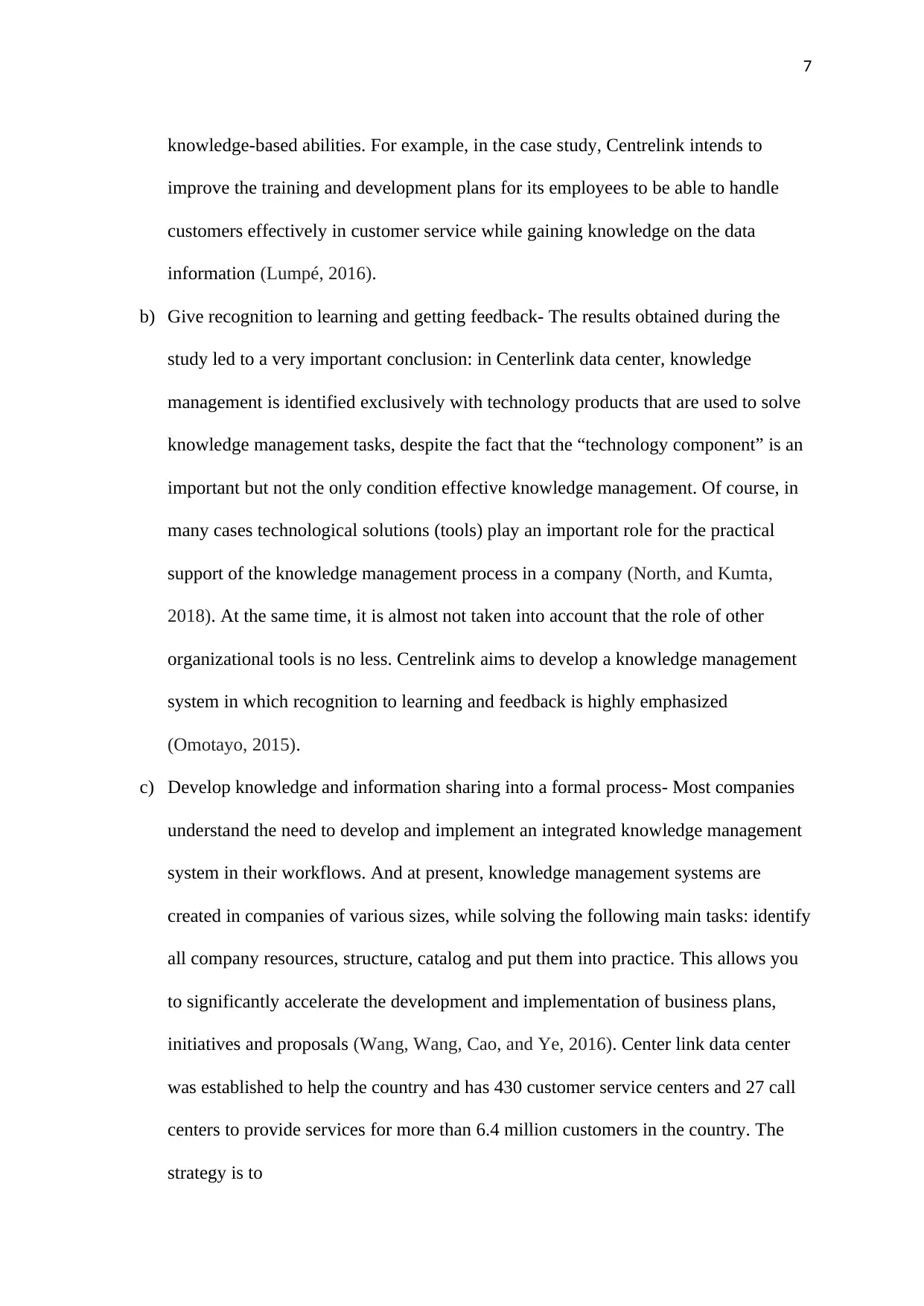
7
knowledge-based abilities. For example, in the case study, Centrelink intends to
improve the training and development plans for its employees to be able to handle
customers effectively in customer service while gaining knowledge on the data
information (Lumpé, 2016).
b) Give recognition to learning and getting feedback- The results obtained during the
study led to a very important conclusion: in Centerlink data center, knowledge
management is identified exclusively with technology products that are used to solve
knowledge management tasks, despite the fact that the “technology component” is an
important but not the only condition effective knowledge management. Of course, in
many cases technological solutions (tools) play an important role for the practical
support of the knowledge management process in a company (North, and Kumta,
2018). At the same time, it is almost not taken into account that the role of other
organizational tools is no less. Centrelink aims to develop a knowledge management
system in which recognition to learning and feedback is highly emphasized
(Omotayo, 2015).
c) Develop knowledge and information sharing into a formal process- Most companies
understand the need to develop and implement an integrated knowledge management
system in their workflows. And at present, knowledge management systems are
created in companies of various sizes, while solving the following main tasks: identify
all company resources, structure, catalog and put them into practice. This allows you
to significantly accelerate the development and implementation of business plans,
initiatives and proposals (Wang, Wang, Cao, and Ye, 2016). Center link data center
was established to help the country and has 430 customer service centers and 27 call
centers to provide services for more than 6.4 million customers in the country. The
strategy is to
knowledge-based abilities. For example, in the case study, Centrelink intends to
improve the training and development plans for its employees to be able to handle
customers effectively in customer service while gaining knowledge on the data
information (Lumpé, 2016).
b) Give recognition to learning and getting feedback- The results obtained during the
study led to a very important conclusion: in Centerlink data center, knowledge
management is identified exclusively with technology products that are used to solve
knowledge management tasks, despite the fact that the “technology component” is an
important but not the only condition effective knowledge management. Of course, in
many cases technological solutions (tools) play an important role for the practical
support of the knowledge management process in a company (North, and Kumta,
2018). At the same time, it is almost not taken into account that the role of other
organizational tools is no less. Centrelink aims to develop a knowledge management
system in which recognition to learning and feedback is highly emphasized
(Omotayo, 2015).
c) Develop knowledge and information sharing into a formal process- Most companies
understand the need to develop and implement an integrated knowledge management
system in their workflows. And at present, knowledge management systems are
created in companies of various sizes, while solving the following main tasks: identify
all company resources, structure, catalog and put them into practice. This allows you
to significantly accelerate the development and implementation of business plans,
initiatives and proposals (Wang, Wang, Cao, and Ye, 2016). Center link data center
was established to help the country and has 430 customer service centers and 27 call
centers to provide services for more than 6.4 million customers in the country. The
strategy is to
Paraphrase This Document
Need a fresh take? Get an instant paraphrase of this document with our AI Paraphraser

8
1. Store data
2. Analyze data
3. Reporting systems and spatial analysis
4. Data handling and knowledge management
1. Store data
2. Analyze data
3. Reporting systems and spatial analysis
4. Data handling and knowledge management
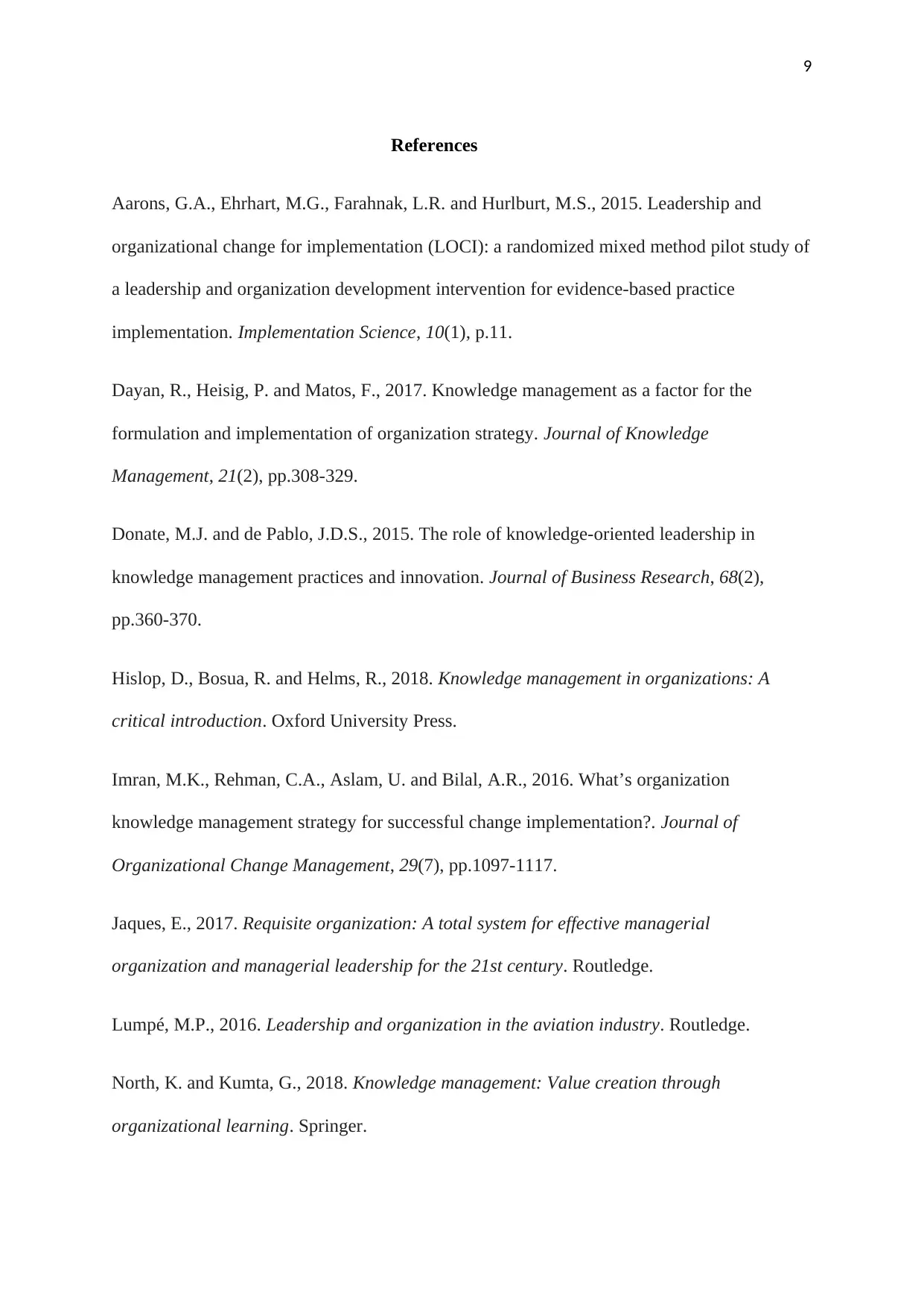
9
References
Aarons, G.A., Ehrhart, M.G., Farahnak, L.R. and Hurlburt, M.S., 2015. Leadership and
organizational change for implementation (LOCI): a randomized mixed method pilot study of
a leadership and organization development intervention for evidence-based practice
implementation. Implementation Science, 10(1), p.11.
Dayan, R., Heisig, P. and Matos, F., 2017. Knowledge management as a factor for the
formulation and implementation of organization strategy. Journal of Knowledge
Management, 21(2), pp.308-329.
Donate, M.J. and de Pablo, J.D.S., 2015. The role of knowledge-oriented leadership in
knowledge management practices and innovation. Journal of Business Research, 68(2),
pp.360-370.
Hislop, D., Bosua, R. and Helms, R., 2018. Knowledge management in organizations: A
critical introduction. Oxford University Press.
Imran, M.K., Rehman, C.A., Aslam, U. and Bilal, A.R., 2016. What’s organization
knowledge management strategy for successful change implementation?. Journal of
Organizational Change Management, 29(7), pp.1097-1117.
Jaques, E., 2017. Requisite organization: A total system for effective managerial
organization and managerial leadership for the 21st century. Routledge.
Lumpé, M.P., 2016. Leadership and organization in the aviation industry. Routledge.
North, K. and Kumta, G., 2018. Knowledge management: Value creation through
organizational learning. Springer.
References
Aarons, G.A., Ehrhart, M.G., Farahnak, L.R. and Hurlburt, M.S., 2015. Leadership and
organizational change for implementation (LOCI): a randomized mixed method pilot study of
a leadership and organization development intervention for evidence-based practice
implementation. Implementation Science, 10(1), p.11.
Dayan, R., Heisig, P. and Matos, F., 2017. Knowledge management as a factor for the
formulation and implementation of organization strategy. Journal of Knowledge
Management, 21(2), pp.308-329.
Donate, M.J. and de Pablo, J.D.S., 2015. The role of knowledge-oriented leadership in
knowledge management practices and innovation. Journal of Business Research, 68(2),
pp.360-370.
Hislop, D., Bosua, R. and Helms, R., 2018. Knowledge management in organizations: A
critical introduction. Oxford University Press.
Imran, M.K., Rehman, C.A., Aslam, U. and Bilal, A.R., 2016. What’s organization
knowledge management strategy for successful change implementation?. Journal of
Organizational Change Management, 29(7), pp.1097-1117.
Jaques, E., 2017. Requisite organization: A total system for effective managerial
organization and managerial leadership for the 21st century. Routledge.
Lumpé, M.P., 2016. Leadership and organization in the aviation industry. Routledge.
North, K. and Kumta, G., 2018. Knowledge management: Value creation through
organizational learning. Springer.
⊘ This is a preview!⊘
Do you want full access?
Subscribe today to unlock all pages.

Trusted by 1+ million students worldwide

10
Omotayo, F.O., 2015. Knowledge Management as an important tool in Organisational
Management: A Review of Literature. Library Philosophy and Practice, 1(2015), pp.1-23.
Wang, Z., Wang, N., Cao, J. and Ye, X., 2016. The impact of intellectual capital–knowledge
management strategy fit on firm performance. Management Decision, 54(8), pp.1861-1885.
Omotayo, F.O., 2015. Knowledge Management as an important tool in Organisational
Management: A Review of Literature. Library Philosophy and Practice, 1(2015), pp.1-23.
Wang, Z., Wang, N., Cao, J. and Ye, X., 2016. The impact of intellectual capital–knowledge
management strategy fit on firm performance. Management Decision, 54(8), pp.1861-1885.
1 out of 10
Related Documents
Your All-in-One AI-Powered Toolkit for Academic Success.
+13062052269
info@desklib.com
Available 24*7 on WhatsApp / Email
![[object Object]](/_next/static/media/star-bottom.7253800d.svg)
Unlock your academic potential
Copyright © 2020–2025 A2Z Services. All Rights Reserved. Developed and managed by ZUCOL.





